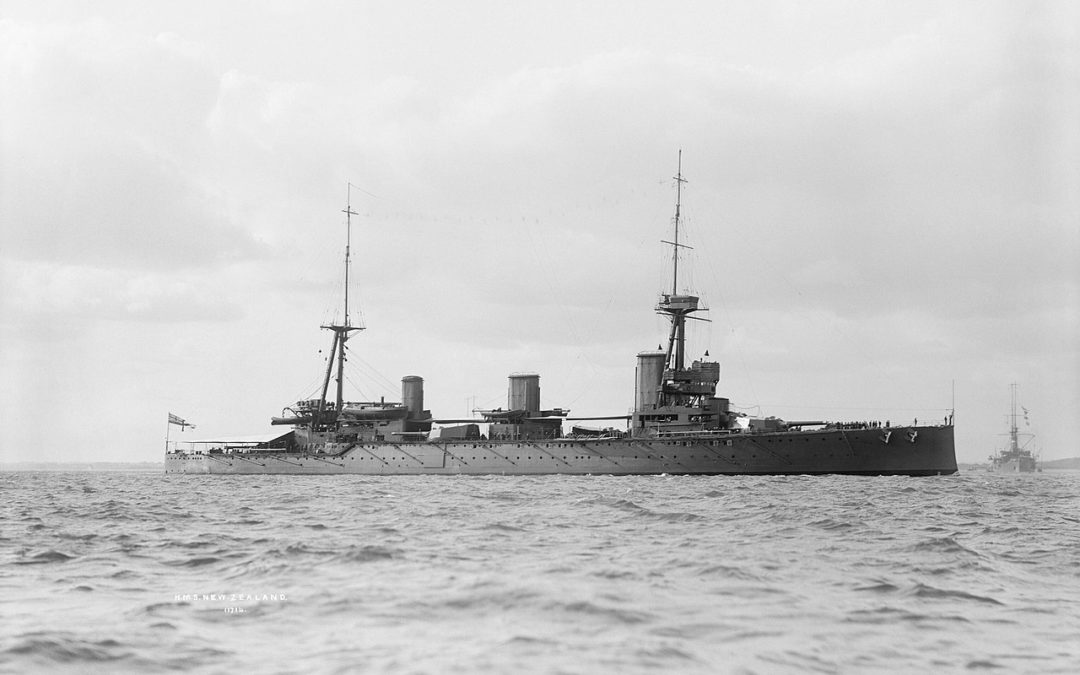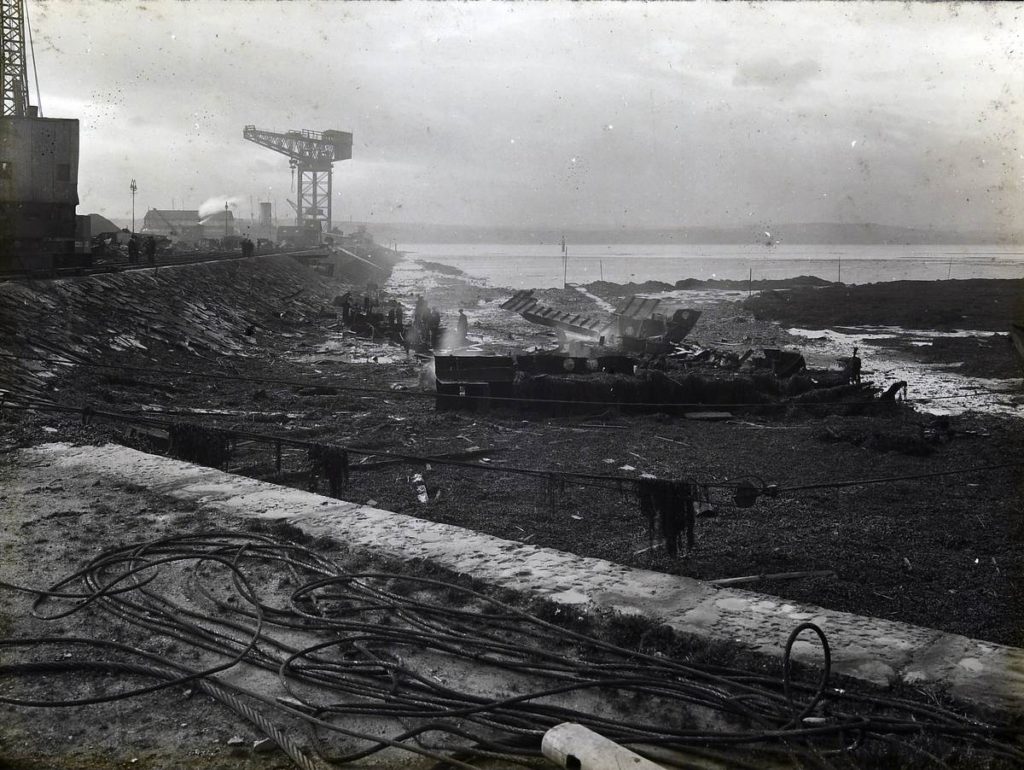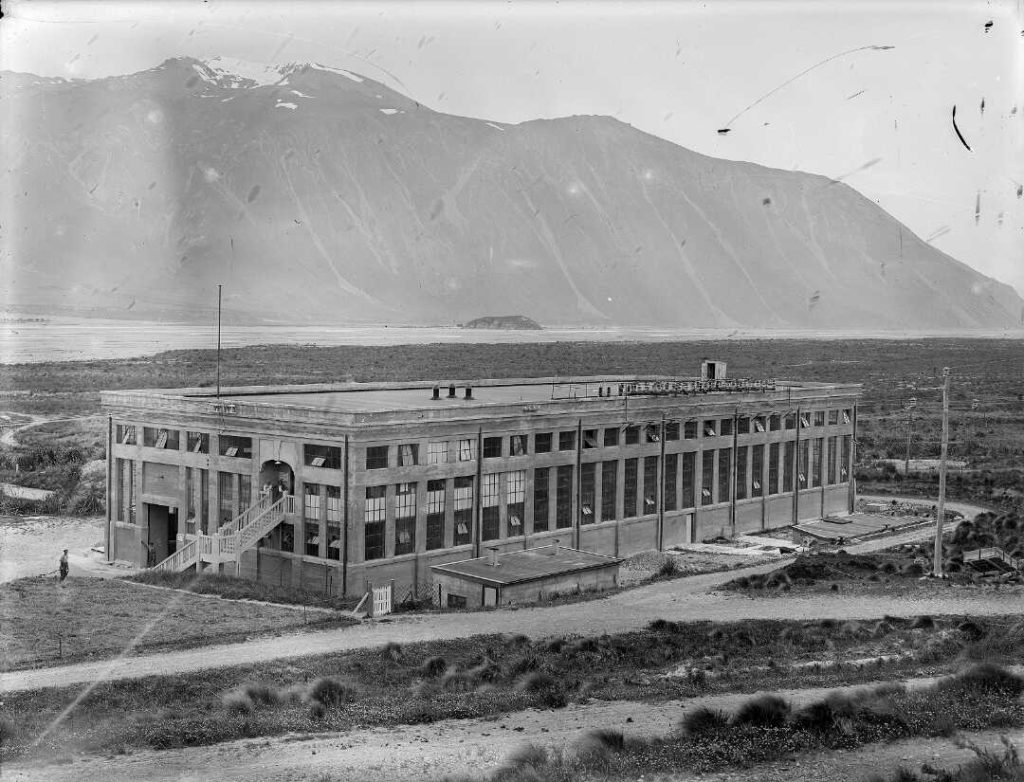One of the many myths about the battlecruiser HMS New Zealand – the ship built as a gift from New Zealand to Britain in 1909 – is that she was unaffordable for a small Dominion of just under a million people. In the previous article I showed that this was simply not so: the cost was negligible against the scale of the economy and state spending – check it out. But what about the fact that the debt wasn’t cancelled until the 1944-45 financial year, about 21 years after the last slash of the scrappers’ gas-axe? I looked into this when I wrote Battlecruiser New Zealand: A Gift to Empire (Seaforth/USNI Press 2021), and ended up conducting a forensic examination of the accounts.
This painted a different picture from the usual mythology. Let me explain – but a few words about the underlying debt process first, though. You’ll note I refer to ‘cancelling the ledger entries’. Like all major government spending of the day, both in New Zealand and elsewhere, HMS New Zealand was funded through a debt-management programme where sums authorised for the ship were drawn into a borrowing process in which individual loans were disconnected from specific spending. All was accounted for through ledger entries written by hand, in ink, in non-decimal pounds-shillings-and-pence, by long-suffering government clerks.
The process was standard for all governments: they worked on cash flows, not cash accumulations, and major capital expenses were often funded by borrowing.[1] Britain, for instance, funded naval infrastructure that way after 1896.[2] For an explanation of how cash flows work at this level, have a look at an economic paper I co-authored about an early analogue computer, designed as a teaching tool to show the process: https://www.rbnz.govt.nz/research-and-publications/reserve-bank-bulletin/2007/rbb2007-70-04-04
Where did HMS New Zealand fall in this system? In the earlier article we looked at how governments measured the affordability of any major purchase by their ability to meet interest payments on loans. These were often raised incrementally to obtain cash for multiple capital projects at once, and most did not require repayment for 25 or 30 years. New Zealand’s public works programme had been using the system for decades by 1909, involving sums that dwarfed those required for the battlecruiser. However, because HMS New Zealand was a ‘special’, government also set up a ‘sinking fund’ – in effect, a savings scheme. The idea was that an additional sum of around 4 percent the cost of the ship would be set aside annually and invested with the Public Trust Office. Once the full sum attributed to the ship had been accumulated, the fund would be available to cancel the relevant entries in the government debt register. Meanwhile it could be re-lent, creating a small fiscal stimulus.
There was nothing unusual about this: similar systems had been used in Britain for years. A ‘sinking fund’, for example, was set up to (eventually) pay for the loans raised under the annual Naval Works Loan Acts. A projected higher contribution to that fund for FY 1905-06 was one of the factors behind Admiral Sir John Fisher’s naval reform programme: he was specifically instructed to make compensatory cash-flow savings across the Royal Navy’s operations.[3] In New Zealand, ‘sinking funds’ were set up by 1909 to cover the cost of – among other things – Westport harbour works. So adding another for HMS New Zealand was not unusual.
In 1913, New Zealand’s Minister of Defence, James Allen, told Parliament that the battlecruiser sinking fund was growing at about £50,000 per annum, plus interest, and ‘will be sufficient to repay the loan in about seventeen years’.[4] This was a relatively quick schedule. However, the First World War provoked a dislocating quantity of debt atop earlier sums, and in 1922, the New Zealand government arranged for a little over £27 million of public debt to be converted to a loan from the British government, paid off in six-monthly instalments. This was known as the Imperial Funded Debt.
By this time the ‘sinking fund’ credit balance was £963,131 short of the sum required to wholly cancel the battlecruiser’s book debt. This shortfall was instead defined as a new ledger entry in the new ‘Imperial Funded Debt’ ledger. That left a balance of £832,035 on the original ‘Naval Defence Account’ ledger against the ship, which the ‘sinking fund’ could have cancelled. However, the ‘sinking fund’ was left to accumulate at £71,807 per annum, plus compound interest.[5] The battlecruiser debt, in short, had been split in two by accounting decision, one part subject to a different repayment arrangement, with the ‘savings scheme’ now applying only to half.
Two years later, in 1924, the New Zealand government received a windfall of £20,000, the sale price of the ship for scrap. The administration of William Massey decided to use it to part-redeem loans for electrical reticulation. However, this was stopped by the Controller and Auditor-General, George Campbell, who insisted it was set against the ‘naval defence loans included in the [Imperial] Funded Debt’.[6] The ledger entry was adjusted accordingly.[7]
That drew attention to the ‘sinking fund’, which now stood well above the remaining figure in the original Naval Defence ledger it was meant to pay on maturity. Campbell suggested this surplus should also be transferred to offset the Imperial Funded Debt, reducing the battlecruiser line entry there. In the end around £180,000 was transferred into the Public Debt Redemption Fund from the ‘sinking fund’, plus the scrapping price.[8]
This was not where the story ended, though. Soon afterwards the remaining ‘sinking fund’ balance was swept up in the Repayment of Public Debt Act 1925 and – standing at £876,379-19-5 on 31 March 1926 – merged with the Public Debt Redemption Fund.[9] This was designed to let the New Zealand government arbitrarily redeem older debt instruments, and meanwhile offer new stock at more favourable terms. But it also netted debt against any cash held by government, swallowing the battlecruiser fund.
HMS New Zealand’s debt ledger entries, in short, were now subject to the same repayment arrangements as every other ledger entry. Therein lay the problem. The 1920s were indifferent years for New Zealand, economically; and then the Great Depression hit government finances hard.[10] One result was that although government continued to meet its loan payment obligations, a variety of ledger debts went untouched, including those attached to HMS New Zealand. The ‘Imperial Funded Debt’ ledger entry was down to £577,446-11-5 by 1931-32, largely thanks to the sums deducted from it in 1924, and was shown as due in 1945.[11] This remained unchanged at the end of the 1942-43 financial year.[12] The part of the debt separately accounted via the Repayment of the Public Debt Act 1925 stood at £812,209-0-11 the same year.[13]
There things sat until the 1943-44 financial year when government launched a massive economic recovery programme, primarily on the back of war income. Debit entries in the government debt ledger were arbitrarily struck off, balancing the books as money from war exports enabled unrelated debentures and securities to be repaid early. On the basis of early repayment of various securities, a total of £858,902-5-5 was cancelled from the Naval Defence Account at the end of the 1943-44 financial year, along with other capital figures on the ledger for other unrelated debts.[14] A final £530,753-16-0 from the naval account was cancelled in the 1944-45 year, again joining other unrelated debts, on the basis of early repayments of securities otherwise due between January 1945 and April 1963.[15]
These sums were primarily the ledger balances attributed to HMS New Zealand. From a book-keeping perspective, then, the ship was indeed finally ‘paid for’ in 1944-45. But it was wholly an accounting exercise. The more important point is the comment in a 1929 audit report that, if the original ‘sinking fund’ had not been ‘disturbed’, it would have accumulated enough by 1930-31 to cover the grand total of £1,795,169, four shillings and eleven pence finally attributed to the battlecruiser. This wasn’t the purchase price from Fairfield Shipbuilding: it included debt-management costs.[16] But what this meant was that the ledger entries set against the ship could have been cancelled in FY 1930-31, as originally intended. Instead, the New Zealand government played book-keeping games.
My book on HMS New Zealand, a from-concept-to-scrapping story that takes in her First World War experience is published by Seaforth and USNI Press. Check it out.
Copyright © Matthew Wright 2022
[1] For a discussion of the British national debt of the day see Harold Cox, ‘The Public Debt of Great Britain’, The North American Review, Vol. 173, No. 538, September 1901, University of Northern Iowa.
[2] https://api.parliament.uk/historic-hansard/bills/naval-works-bill
[3] See Selborne to Fisher, May 14 1904, Inclosure [sic], in P. K. Kemp (ed), The Fisher Papers, Vol. I, Navy Records Society, London 1960, p. xvii.
[4] AJHR 1913, Session I, B-06, ‘Financial statement (in Committee of Supply 6th August 1913) by the Minister of Finance, The Hon. James Allen, p. xxvii.
[5] Archives New Zealand (ANZ) R11741448 ADAV 16028 A5 141/23/48 Naval Defence Sinking Fund Account 1921-1938,
‘Battle-cruiser “New Zealand”’. Note the hyphenated term.
[6] ANZ R11741448 ADAV 16028 A5 141/23/48 Naval Defence Sinking Fund Account 1921-1938, Controller and Auditor-General to Secretary of the Treasury, 26 March 1924.
[7] New Zealand Yearbook 1926, https://www3.stats.govt.nz/New_Zealand_Official_Yearbooks/1926/NZOYB_1926.html?_ga=2.123762893.63746472.1614892679-1598441439.1614892679#idsect1_1_232106, accessed 4 March 2021.
[8] ANZ R11741448 ADAV 16028 A5 141/23/48 Naval Defence Sinking Fund Account 1921-1938, Controller and Auditor-General to Secretary of the Treasury, 26 March 1924.
[9] AJHR 1926, B-8, ‘The Naval Defence Act Sinking Fund’, p. 1.
[10] Michael Reddell, ‘The New Zealand Debt Conversion Act 1933: a case study in coercive domestic public debt restructuring’, Reserve Bank of New Zealand Bulletin, Vol. 75, No. 1, March 2012.
[11] AJHR 1932 Session I-II, B-01, Part 3, ‘Public accounts for the financial year 1931-1932, Part 3’, p. 21.
[12] See, e.g. AJHR 1943 Session I, B-01, Part 2, ‘Public accounts for the financial year 1942-43, Part 2, p. xi.
[13] Ibid, p. xi.
[14] AJHR 1944, Session I, B-02, ‘Repayment of the public debt: report and accounts of the public debt commission for the year ended 31st March 1944’, p. 2.
[15] AJHR 1945, Session I, B-02, ‘Repayment of the public debt: report and accounts of the public debt commission for the year ended 31st March 1945’, p. 2.
[16] ANZ R11741448 ADAV 16028 A5 141/23/48 Naval Defence Sinking Fund Account 1921-1938, ‘Naval Defence Sinking Fund’.






Recent Comments